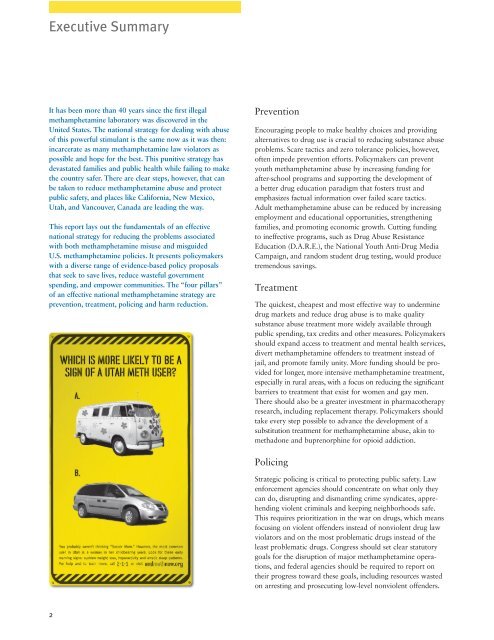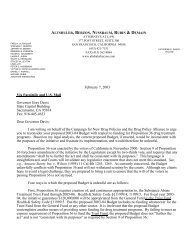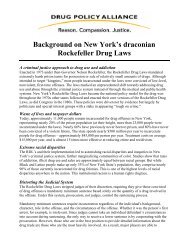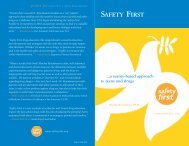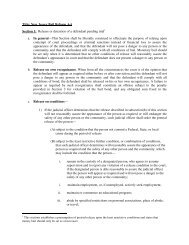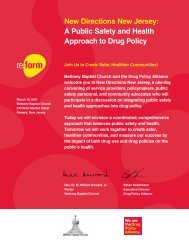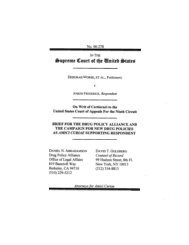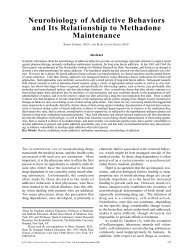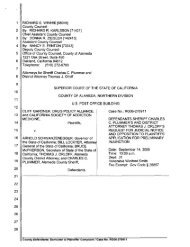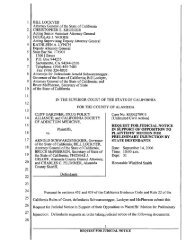A Four Pillars Approach to Methamphetamine - Drug Policy Alliance
A Four Pillars Approach to Methamphetamine - Drug Policy Alliance
A Four Pillars Approach to Methamphetamine - Drug Policy Alliance
You also want an ePaper? Increase the reach of your titles
YUMPU automatically turns print PDFs into web optimized ePapers that Google loves.
Executive Summary<br />
It has been more than 40 years since the first illegal<br />
methamphetamine labora<strong>to</strong>ry was discovered in the<br />
United States. The national strategy for dealing with abuse<br />
of this powerful stimulant is the same now as it was then:<br />
incarcerate as many methamphetamine law viola<strong>to</strong>rs as<br />
possible and hope for the best. This punitive strategy has<br />
devastated families and public health while failing <strong>to</strong> make<br />
the country safer. There are clear steps, however, that can<br />
be taken <strong>to</strong> reduce methamphetamine abuse and protect<br />
public safety, and places like California, New Mexico,<br />
Utah, and Vancouver, Canada are leading the way.<br />
This report lays out the fundamentals of an effective<br />
national strategy for reducing the problems associated<br />
with both methamphetamine misuse and misguided<br />
U.S. methamphetamine policies. It presents policymakers<br />
with a diverse range of evidence-based policy proposals<br />
that seek <strong>to</strong> save lives, reduce wasteful government<br />
spending, and empower communities. The “four pillars”<br />
of an effective national methamphetamine strategy are<br />
prevention, treatment, policing and harm reduction.<br />
Prevention<br />
Encouraging people <strong>to</strong> make healthy choices and providing<br />
alternatives <strong>to</strong> drug use is crucial <strong>to</strong> reducing substance abuse<br />
problems. Scare tactics and zero <strong>to</strong>lerance policies, however,<br />
often impede prevention efforts. <strong>Policy</strong>makers can prevent<br />
youth methamphetamine abuse by increasing funding for<br />
after-school programs and supporting the development of<br />
a better drug education paradigm that fosters trust and<br />
emphasizes factual information over failed scare tactics.<br />
Adult methamphetamine abuse can be reduced by increasing<br />
employment and educational opportunities, strengthening<br />
families, and promoting economic growth. Cutting funding<br />
<strong>to</strong> ineffective programs, such as <strong>Drug</strong> Abuse Resistance<br />
Education (D.A.R.E.), the National Youth Anti-<strong>Drug</strong> Media<br />
Campaign, and random student drug testing, would produce<br />
tremendous savings.<br />
Treatment<br />
The quickest, cheapest and most effective way <strong>to</strong> undermine<br />
drug markets and reduce drug abuse is <strong>to</strong> make quality<br />
substance abuse treatment more widely available through<br />
public spending, tax credits and other measures. <strong>Policy</strong>makers<br />
should expand access <strong>to</strong> treatment and mental health services,<br />
divert methamphetamine offenders <strong>to</strong> treatment instead of<br />
jail, and promote family unity. More funding should be provided<br />
for longer, more intensive methamphetamine treatment,<br />
especially in rural areas, with a focus on reducing the significant<br />
barriers <strong>to</strong> treatment that exist for women and gay men.<br />
There should also be a greater investment in pharmacotherapy<br />
research, including replacement therapy. <strong>Policy</strong>makers should<br />
take every step possible <strong>to</strong> advance the development of a<br />
substitution treatment for methamphetamine abuse, akin <strong>to</strong><br />
methadone and buprenorphine for opioid addiction.<br />
Policing<br />
Strategic policing is critical <strong>to</strong> protecting public safety. Law<br />
enforcement agencies should concentrate on what only they<br />
can do, disrupting and dismantling crime syndicates, apprehending<br />
violent criminals and keeping neighborhoods safe.<br />
This requires prioritization in the war on drugs, which means<br />
focusing on violent offenders instead of nonviolent drug law<br />
viola<strong>to</strong>rs and on the most problematic drugs instead of the<br />
least problematic drugs. Congress should set clear statu<strong>to</strong>ry<br />
goals for the disruption of major methamphetamine operations,<br />
and federal agencies should be required <strong>to</strong> report on<br />
their progress <strong>to</strong>ward these goals, including resources wasted<br />
on arresting and prosecuting low-level nonviolent offenders.<br />
2


